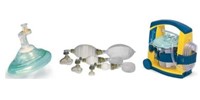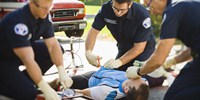Quality CPR
 |
Cardiopulmonary Resuscitation (CPR) is the method of providing oxygen and blood circulation through the delivery of rescue breathing and chest compressons to victims of sudden cardiac arrest. This procedure ensures that a critical flow of oxygenated blood is maintained to the brain and other vital organs during a resusitation attempt.
According to the 2005 AHA and ERC guidelines , high-quality CPR, particularly effective chest compressions, contributes significantly to the successful resuscitation of cardiac arrest patients. The guidelines recommend that rescuers minimize interruptions to chest compressions and suggest that rescuers "push at least 4-5 cms" at a rate 100 compressions per minute. The full 2005 guidelines can be viewed here: AHA
|
 The Chain of Survival
The Chain of Survival
is generally accepted as a description of the timely events and treatment it takes for victims to survive unexpected cardiac arrest. Early CPR is the critical link that can buy life-saving time before defibrillation.





